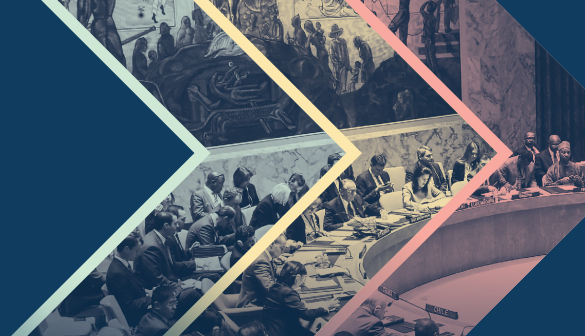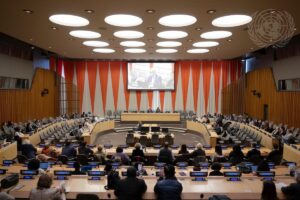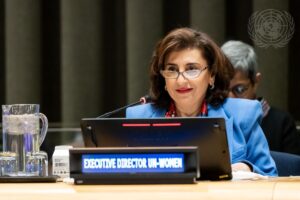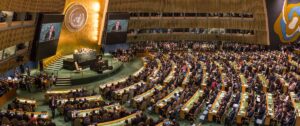Executive Summary
“Inspired by reform proposals found in this study, the Albright-Gambari Commission report, and related research, we hope that world leaders and civil society will work together in the run-up to the 2024 Summit, to ensure that present and future generations realize a vision of justice and security for all.”
-Haifa Fahoum Al Kaylani, José Antonio Ocampo, Shyam Saran, and Jane Holl Lute (Foreword to GGIR’23)
The world needs better ways to manage its many, growing problems. Engaging new voices, instruments, networks, knowledge, and structures is the key to coping with today’s and future global challenges, which include, but are not limited to, renewed Great Power tensions, deepening Global North-South divides, virulent nationalism, runaway climate change, unconstrained artificial intelligence, and a persistent and growing global trust deficit.
Against this backdrop, the analysis and recommendations presented in this inaugural Global Governance Innovation Report (GGIR) are intended to encourage more imaginative and forward-leaning policy conversations in the run-up to the 2024 Summit of the Future in New York—a generational opportunity to refashion our approaches to tackling complex global problems that no single country or institution is capable of addressing on its own. This inaugural GGIR focuses on Redefining Approaches to Peace, Security & Humanitarian Action, while helping to further refine and operationalize the concepts and proposals introduced in UN Secretary-General António Guterres’ New Agenda for Peace.
Today, global governance has come to denote a particular telos (purpose) and a particular modus (method). Its overarching goal is the steering of institutions and resources to provide for global public goods and tackle global challenges effectively. For global governance to be legitimate and authoritative in contemporary terms, it needs to be conducted in an evidenced-based, inclusive, networked, equitable, and future-oriented way.
Informed by this understanding, the GGIR debuts two new annual diagnostic tools for measuring contributions to global leadership and cooperation, initially of G7 and BRICS countries: a Global Governance Index and a Global Governance Survey. The Index ranks the twelve countries across five thematic domains of global leadership, including leadership of and support for multilateral institutions. In this inaugural Index, Germany earned the highest overall score, and Russia the lowest.
For the Global Governance Survey, citizens of the twelve countries were surveyed regarding the same five domains. Asked whether they thought the world was “going in the right [or wrong] direction,” “wrong” led by nearly two to one overall, though Chinese and Indian respondents saw a world moving in the “right” direction by substantial majorities. Primary reasons given by other countries’ citizens for their pessimism included: war and conflict (flagged by 50 percent of respondents), worsening economy / jobs / inflation / poverty (noted by 38 percent), and increasing corruption (23 percent).
GGIR ’23 further explores how such global challenges to international peace and security aggravate existing—and create new—humanitarian crises. It has long been recognized that the international community needs to think beyond existing responses and capacities to empower itself to tackle these challenges. Underlying such a recognition is also a broader paradigmatic shift in understanding peace, security, and humanitarian action in the current age, which is indispensable for a true reimagination of the global governance architecture, the way it operates, and the tools it should wield.
Recently, the UN Secretary-General’s High-Level Advisory Board on Effective Multilateralism (HLAB) coined the term “mutually assured survival” and called for the Summit of the Future to adopt a new definition of collective security that goes beyond traditional threats and covers, for instance, environmental challenges, socioeconomic inequalities, and technological risks. This reconceptualization is a culmination of several decades of modernizing our thinking about global peace and security, which includes such breakthrough concepts as positive peace (the integration of human society), human security, the responsibility to protect, and, more recently, networked and inclusive multilateralism, as defined in the Secretary-General’s 2021 report, Our Common Agenda. This approach also reinforces an understanding of humanitarian action aimed at alleviating human suffering, protecting lives, and meeting the basic needs of affected populations, in response to armed conflict and natural disasters.
With more violent conflicts active now than at any time since the end of the Second World War, GGIR ’23adopts—beginning with its cover design—a “traffic light approach” on the Road to the 2024 Summit, with an emphasis on proactive measures to prevent and lower the risk of deadly conflict before crises can escalate into massive human suffering and material damage (Green Light). Cautious yet deliberate steps toward disarmament can build short-term confidence and boost longer-term security conditions for applying conflict management tools effectively—and avoiding any head-on collisions in the form of an armed confrontation (Yellow Light). Finally, when all steps to mediate, improve confidence and security, and avert the outbreak or recurrence of violence fail, a humanitarian catastrophe may ensue, requiring a different kind of international response and institutional set-up, with the overriding and urgent goal of saving lives (Red Light, aka Red Alert). With an eye toward raising the ambition of the Secretary-General’s New Agenda for Peace and the wider agenda for the Summit of the Future, among the report’s two dozen chief recommendations are:

Reimagining Prevention, Peacemaking, Peacekeeping, and Post-Conflict Peacebuilding (The “4P’s”)
Early Warning and Action: Improving conflict analysis, early warning, and early action capabilities within the UN’s major intergovernmental organs for peace and security means first designating responsibility within and equipping the UN Department of Political and Peacebuilding Affairs and Department of Peace Operations with the tools, resources, and mandate to work out—with the Security Council, the Peacebuilding Commission, and General Assembly—the signs and factors associated with mass atrocity events. An upgraded early warning system could, in turn, support a new Peacebuilding Audit, modeled on the Human Rights Council’s Universal Periodic Review. The monitoring of various national indicators linked with conflict outbreaks would better inform decision-making by major UN bodies, enabling earlier and more effective preventive action.
New Civilian Response Capability: The initiative could include a rapidly deployable cadre of 500 international staff possessing technical expertise, along with fifty senior mediators and Special Envoys/Representatives of the Secretary-General, with emphasis on recruitment of women and youth leaders in support of prevention, peacemaking, peacekeeping, and post-conflict peacebuilding objectives. Ideally, these teams would be complemented by a standby component of highly skilled and periodically trained international civil servants, up to two thousand strong, drawn voluntarily from across the UN system.

Whither Disarmament? WMDs, Conventional Weapons & New Tech
Reinforce Existing Nuclear Policy Infrastructure and Build Conditions for a New Paradigm:As the stockpile of nuclear weapons grows to levels unseen in decades, it is crucial to reinforce arms control and disarmament efforts, wherever possible, by upholding current agreements, introducing or sustaining confidence-building between nuclear states, and cooling the rhetoric of threats (even implicit) to use nuclear weapons. This requires efforts to stabilize existing nuclear infrastructure, while moving toward a renewed arms control and disarmament agenda. Rather than replicate our nuclear history over the next century, going forward global and national security must be pursued with greater attention to human and environmental security imperatives that align better with the positive peace agenda underscored in this report.
New Treaty on Fully Autonomous Weapons: A legally binding treaty on autonomous weapons systems is urgently needed to maintain meaningful human control over the use of force and life-or-death decisions, as artificial intelligence and AI-controlled weapons pose unique threats to peace and security by making warfare more deadly and efficient—and autonomous. Since such weapons challenge established rules and regulations, an international advisory board is needed that brings together experts in international humanitarian law and rules of engagement, military ethicists, and technical experts, as well as religious and interfaith leaders, to explore the implications for warfare from lethal autonomous weapons.

Next Generation Humanitarian Architecture
New Emergency Platform: Further fleshing out the Secretary-General’s proposal, the Emergency Platform should work with the newly suggested UN Futures Lab as a data hub with inputs that are sensitive to threats on impacted populations and outputs made freely available. The Emergency Platform should further serve a knowledge management function as a convenor of different streams of institutional and external knowledge, and as a self-learning system so as to evolve its response between consecutive global shocks.
Financing the Localization Agenda: Past efforts by donors to allocate 25 percent of their funding to local and national humanitarian organizations have faltered (with less than 2 percent directed at local actors, despite two recent attempts at a “Grand Bargain”). One underutilized method for achieving longer-term, more sustainable sources of local funding is “Pooled Funding”—a combined pool of funds from individual donors—which can harness resources and reduce risks more effectively than individual funding to a given organization or project. Reducing regulatory and bureaucratic barriers and differences between development entities can facilitate such mechanisms. Building upon this approach, donor organizations should develop common baseline requirements for compliance and accountability to increase the likelihood of long-term funding.
A New Agenda for Peace & Summit of the Future that Matter
To mobilize an inclusive, smart coalition of governments, civil society, business groups, and international organizations to help ensure that the 2024 Summit of the Future realizes its full potential, five steps are necessary:
For Member States: Commence substantive negotiations without further delay. It is time to get beyond “modalities” considerations for next year’s summit. A powerful, reframed narrative and communications strategy should underscore the high stakes and how—by generating high-level political support, financial and technical assistance, and conceptual clarity for improved global governance—the Summit of the Future and this September’s SDG Summit positively reinforce each other.
For the UN Secretary-General: Stand behind the best recommendations in Our Common Agenda, from the HLAB, and from the Executive Office of the Secretary-General’s Policy Brief series. More than ever, the Secretary-General must look to the moral compass that the UN Charter and the Universal Declaration of Human Rights provide: a global civic ethic that empowers him, uniquely and unapologetically, to speak for humanity and the planet. He has little to lose and much to gain by staying the course and continuing to navigate the likely political minefields to achieve overdue changes in how the world is governed.
For Civil Society: Be relentless in convincing UN Ambassadors and their capitals that civil society’s thoughtful and novel ideas on reinvigorating multilateralism can directly impact UN Member States in positive ways. Civil society has stood up a new Summit of the Future Information Bulletin to provide both civil society and UN Missions up-to-date analysis of the various Summit negotiation tracks. Additionally, it brought together in March more than 2,000 representatives registered worldwide for the inaugural, hybrid Global Futures Forum, held across from UN headquarters, to finalize and promote an interim People’s Pact for the Future (iPP) as a civil society declaration of creative reform ideas. While advocacy consultations in New York are helpful to know the lay of the land and build consensus within civil society around select major reforms, the real work in moving governments must be undertaken in capitals, as this is where significant decisions are made.
For the Pact for the Future and all related Tracks: As done for the 2030 Agenda for Sustainable Development (creating individual targets and tracking indicators for all 17 individual SDGs), design a comprehensive Monitoring and Tracking Mechanism to ensure accountability and facilitate course corrections in implementing agreed Summit of the Future outcomes. To encourage successful execution of the Pact for the Future and related strategic frameworks (e.g., a New Agenda for Peace, Global Digital Compact, and Declaration on Future Generations), the UN Secretariat could design an annual progress report to assess implementation gaps and recommend early corrective action.
For Summit of the Future Follow-through: Consider a comprehensive Charter Review process through Article 109, culminating in 2026, to realize several anticipated Pact for the Future Charter amendments. The framers of the UN Charter in 1945 foresaw that it was an imperfect instrument that would need to be updated to reflect changing global political realities, threats, and opportunities, to ensure the organization’s continued practical relevance and decision-making efficiency. Member States could recommend a high-level Article 109 UN Charter Review Conference, to be held by late 2026 and preceded by an appropriate preparatory process, to take forward Summit of the Future commitments requiring Charter revision. This would ensure that momentum is sustained, in 2025 and 2026, to facilitate effective follow-through. Through a combination of critical mass, quality ideas, and deft multilateral diplomacy, civil society can team up with champion governments and forward-leaning leaders in global and regional institutions to maximize the impact of the New Agenda for Peace and Summit of the Future. Together, they must demonstrate the many tangible ways a modernized United Nations and related global and regional bodies can help countries and communities deliver on the 2030 Agenda for Sustainable Development and the Paris Climate Agreement, as well as help them to avoid new outbreaks (or recurrence) of deadly conflict. Equally pivotal, they must work skillfully to ensure that this generational opportunity to define “the future we want” for today’s younger generation—and all future generations—really becomes the future we and they get.




